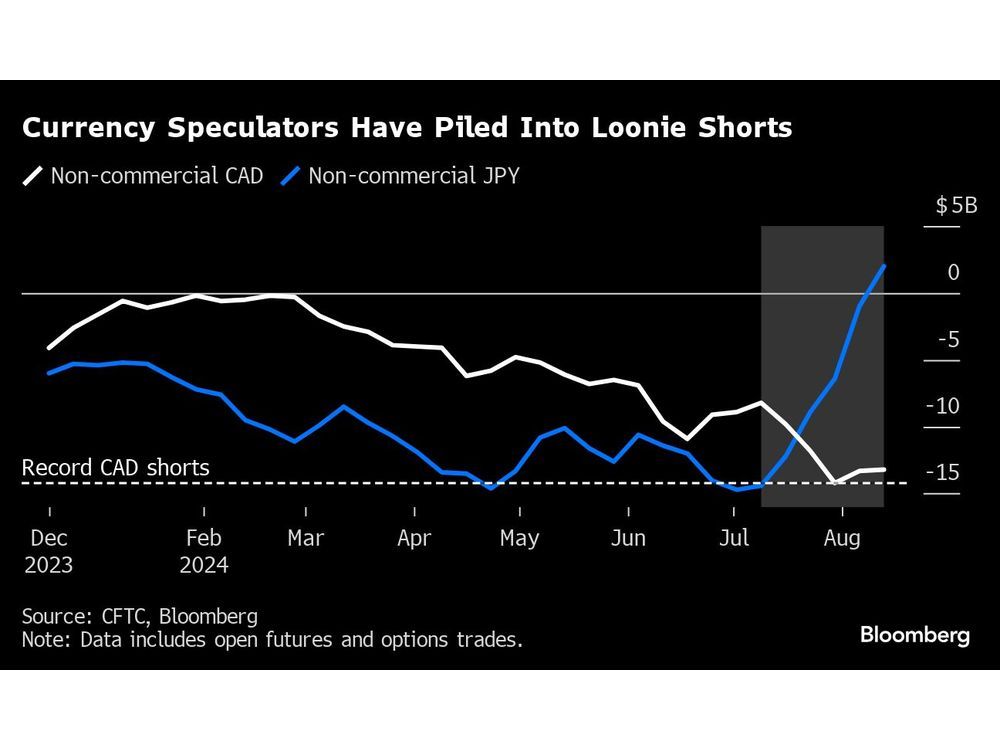
Hedge funds and asset managers amassed a roughly US$14 billion short position in the Canadian dollar

Article content
Traders have piled into record wagers against the loonie, betting that a rapidly slowing Canadian economy and a dovish central bank will deepen the currency’s 2024 decline.
Hedge funds and asset managers amassed a roughly US$14 billion short position in the Canadian dollar in early August, Commodity Futures Trading Commission data show. It was the largest for the loonie in data going back to the 1990s and nearly double the prior peak bet on losses in Canada’s currency. The stance has since shrunk a bit as the loonie has strengthened the past few weeks, but it’s still quadruple the size of the next biggest currency short: against the Swiss franc.
Advertisement 2
Article content
A softening outlook for Canada’s economy, in part because of a recent slump in oil, is underpinning the gloomy mood. The country unexpectedly lost jobs in July, leaving the unemployment rate the highest in more than two years. Inflation, meanwhile, has cooled to the slowest since 2021, cementing bets that the Bank of Canada is set to ease for a third straight meeting. That would come before the United States Federal Reserve delivers the first of its expected interest-rate cuts, later in September.
“That positioning is hovering around multi-decade extremes, which is quite scary,” said Sarah Ying, head of currency strategy at CIBC Capital Markets in Toronto. “Between now and the September Fed meeting, the short Canada positions are safe,” but that may change should the U.S. central bank’s policy message signal deeper weakness in the greenback, she said.

Also driving the weak loonie outlook is a broader slowdown in growth outside Canada. A Citigroup Inc. gauge of global economic surprises has fallen to the lowest since 2021, indicating data releases have been worse than expected. And U.S. job gains were just revised lower by the most since 2009, a worrisome sign for Canada given how intertwined the two economies are.
Article content
Advertisement 3
Article content
It all bodes poorly for the loonie, which tends to trade in concert with expectations for global growth and commodities, given that energy is Canada’s biggest export. Futures on West Texas Intermediate crude touched the lowest since January this week.
At around $1.3580, the Canadian dollar is down 2.5 per cent versus the greenback this year. Among Group of 10 currencies, only the beleaguered yen and the currencies of New Zealand and Norway — both closely tied to the commodities outlook — have weakened more.
“The Canadian dollar tends to underperform the U.S. in an environment where global growth is surprising to the downside relative to consensus expectations,” said Alessio de Longis, a senior portfolio manager at Invesco, who’s underweight the loonie versus the dollar, euro and pound.
While the backdrop looks grim, traders leaning toward a weaker loonie are likely feeling the heat as it has rebounded this month amid broad losses in the U.S. currency — keyed mostly to growing confidence in Fed cuts. The loonie’s 1.6 per cent August rally has it poised for its best month this year, although that gain is the smallest among its major peers versus the greenback.
Advertisement 4
Article content

Against that backdrop, the focus will be on a highly anticipated speech by Fed Chair Jerome Powell at 10 a.m. New York time to gauge whether the market is on track with its pricing of almost a percentage point of total easing by year-end.
While it’s difficult to determine where traders entered short loonie bets, they’re increasingly getting squeezed as the currency gains, said Shaun Osborne, chief foreign-exchange strategist at Scotiabank. “We could be close to an inflection point here from a short-term view.”
Recommended from Editorial
Partly because sentiment appeared stretched, Ying and her CIBC team earlier this month recommended a long bet on the loonie versus the yen.
Market watchers will see on Friday afternoon whether traders are backing down in the face of the loonie’s August recovery, when the CFTC releases the latest positioning data at 3:30 p.m. New York time.
With assistance from Anya Andrianova
Article content


